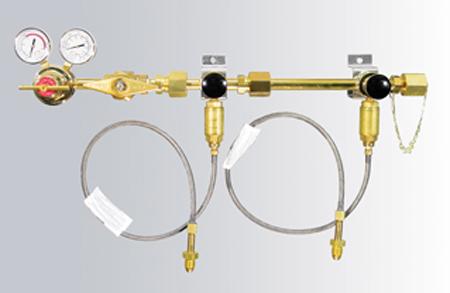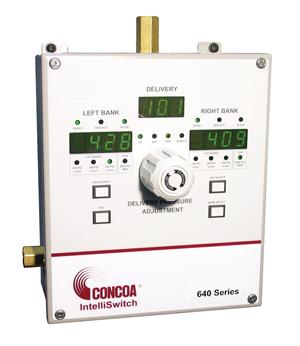Application Specialist
- FMA
- The Fabricator
- FABTECH
- Canadian Metalworking
Categories
- Additive Manufacturing
- Aluminum Welding
- Arc Welding
- Assembly and Joining
- Automation and Robotics
- Bending and Forming
- Consumables
- Cutting and Weld Prep
- Electric Vehicles
- En Español
- Finishing
- Hydroforming
- Laser Cutting
- Laser Welding
- Machining
- Manufacturing Software
- Materials Handling
- Metals/Materials
- Oxyfuel Cutting
- Plasma Cutting
- Power Tools
- Punching and Other Holemaking
- Roll Forming
- Safety
- Sawing
- Shearing
- Shop Management
- Testing and Measuring
- Tube and Pipe Fabrication
- Tube and Pipe Production
- Waterjet Cutting
Industry Directory
Webcasts
Podcasts
FAB 40
Advertise
Subscribe
Account Login
Search
Choosing the correct gas delivery system for metalworking
Pressure and flow will help you determine what you need
- By John Karpus
- September 9, 2013
- Article
- Consumables

Figure 1: You must monitor manual switchover systems and continuously add new full cylinders to prevent workstations from running out of gas.
Whether at a large shipyard or in a small steel fabricating shop, metal fabricators rely on gas products that are delivered and stored in cylinders. From a basic high-pressure cylinder to a large bulk tank, the objective is to have a system in place that will provide cost savings and give you the ability to expand.
The main component for a successful gas delivery system is sizing it for the correct pressure and flow. Supplying gas to an application seems like a simple task—source a gas cylinder and a regulator from a local supplier, connect it, and turn it on.
If it’s a one-off application in which the demand for pressure or flow stays the same, then it is simple. Things get complicated when the application evolves into multiple locations or requires more pressure or flow. When this happens, the gas delivery system will need to be upgraded to ensure performance. Sure, every use point could be outfitted with a cylinder and pressure-reducing regulator, or in the case of higher consumption, you could keep manually changing cylinders as required. However, such an approach is time-consuming and costly. By installing gas cylinders at one main location and controlling them with a basic manifold or switchover manifold, you won’t need to worry about cylinders running out of gas.
Four Types of Gas Switchovers
Manual switchovers have multiple cylinders attached to a manifold that has a pressure-reducing regulator at the outlet. The output pressure of the regulator is then set to feed into an application or piping system. It’s important to monitor these systems, and you must add new full cylinders to prevent the workstations from running out of gas (see Figure 1).
Primary-reserve switchovers have a primary bank of cylinders located on the right side, and a reserve bank of cylinders located on the left side, and each has a regulator with a different setting. For example, you can set one at 300 PSI and one at 200 PSI, with both feeding into a common line. The first cylinder regulator set at 300 PSI keeps the output of the 200-PSI regulator closed as it supplies the piping system. As the primary cylinder—set at 300 PSI—empties and the delivery pressure drops below the 300-PSI setting, the regulator set at 200 PSI (secondary) will open up and start to feed the system. Before the secondary cylinders become empty, you’ll have to add new cylinders to the primary side to continue the uninterrupted supply of gas to the system.
Semiautomatic switchovers are typically pressure-differential in function and are similar to primary-reserve systems. But on these the first regulator has two settings—let’s say 300 PSI and 100 PSI—and a directional knob or lever to change the value, and a second regulator set at 200 PSI feeding into a common line. The first cylinder regulator set at 300 PSI keeps the output of the 200-PSI regulator closed. Again, as the first cylinder empties and the pressure drops below the 300-PSI setting, the second cylinder regulator set at 200 will open up and start to feed the system. When this happens, you can rotate the directional knob or lever to change the setting of the first regulator to 100 PSI, and replace the empty cylinder. When the pressure in the second cylinder drops below 200 PSI, the 100-PSI regulator will then continue to supply the system (see Figure 2).
Fully automatic switchovers work off pressure sensors that monitor the primary and secondary inputs. When the inlet source pressure reaches a predetermined set point, the system switches from primary to secondary automatically (see Figure 3).
Continuous Gas Supply Advantages
According to industry standards, it takes an average of 20 to 30 minutes to change out an empty gas cylinder and replace it with a full one. When multiplied by the number of workstations in a shop, it adds up to a considerable amount of lost time. The other unseen cost is cylinder rental at $0.25 to $0.40 a day for high-pressure cylinders and $1.50 to $3.00 per day for liquid cylinders. By combining multiple cylinders on a basic manifold to supply an application with gas, you can minimize the time required to change out empty cylinders.
A basic manifold, however, still requires monitoring to ensure the process does not run out of gas.
Time for Mode Change
Since gas is at a premium in high-pressure cylinders, the next step in cost savings is a vertical gas/liquid cylinder (VGL) or liquid cylinder. Liquid cylinders are essentially big thermos bottles capable of delivering gas or liquid product to an application.

Figure 3: A fully automatic switchover works off pressure sensors that monitor primary and secondary inputs and automatically switches from primary to secondary sources at predetermined set points.
Liquid cylinders are commonly available for oxygen, nitrogen, argon, and carbon dioxide. One liquid cylinder’s volume is equal to approximately 15 to 20 high-pressure cylinders, and it costs less to fill one liquid cylinder than it does to fill 20 high-pressure cylinders.
Liquid cylinders have a gas-use port, liquid-use port, and vent-connection port. A pressure-building circuit generates additional pressure and flow to the application, and an economizer circuit prevents it from generating gas when demand is low. Safety relief valves set at 230, 350, or 500 PSI ensure internal pressures will never reach the point at which the cylinder could rupture or explode.
With standard liquid argon, nitrogen, and oxygen cylinders, the pressure-building capacity is normally around 300 SCFH, with peak flow of 350 SCFH for short periods.
With standard liquid CO2 cylinders, the pressure-building capacity is typically about 100 SCFH, with peak flow of 150 SCFH for short periods of time. If the application demands more flow than one cylinder can provide, you can add more cylinders.
When choosing a switchover system, remember that pressure-differential
switchovers do not work efficiently with liquid cylinders supplying the product. If the demand for gas is too high for a liquid cylinder to keep up, the head pressure in the cylinder will drop below the switchover point and create a false or premature empty condition. Also, pressure-differential switchovers tend to leave 15 percent or more unused product behind. There also comes a point when the gas flow demand to an application is so great that using multiple liquid cylinders’ internal vaporizing capability is no longer practical.
Pusher System
One solution is to extract the liquid product from the liquid cylinder and put it through an external vaporizer to create larger volumes of gas product. You can connect multiple liquid cylinders to a cryogenic manifold to feed a continuous supply of liquid product to the vaporizer (see Figure 4).
A pusher system uses the entire liquid product inside a cylinder and maintains constant pressure and flow to the vaporizer and downstream application. With a pusher system, the outlet pressure (gas) of a separate liquid cylinder (pusher) is used to force the liquid product out of the (slave) liquid cylinder through the cryogenic manifold and into the vaporizer. An uninterrupted supply of gas can then be supplied to a gas blender and a piping system by locating a pusher system on either side of a fully automatic switchover system.
With the pusher system, you are limited only by the vaporizer’s rated capacity to produce gas product and the number of cylinders hooked up to supply the application.
Facility Manifolding and Piping Systems
The most cost-effective way to supply gas to multiple workstations is by installing a piping system that connects to a cylinder manifold, switchover system, or bulk tank. Again, the key here is to size the piping and gas delivery system for the total combined pressure and flow required at all the use points. This is necessary to prevent “starving” any of the downstream use points.

Figure 4: A pusher system uses a cylinder’s entire liquid product and maintains constant pressure and flow.
When sizing the piping system it is important to use the correct pipe or tube size to ensure the gas pressure and flow will not be restricted. It’s important to consider future expansion of the piping system before you select the piping size. Since the difference in cost of materials is minimal, it’s a good idea to err on the side of caution and use a larger pipe or tube size.
The two types of piping systems are dead-end and looped. With a dead-end system, piping starts at the cylinder manifold and ends at the last drop or use point. With a looped system, the gas is always able to travel in two ways to the last use point. By using the correct pipe size and looping the gas piping system, you can ensure that none of the use points will be affected if there is a large flow demand at one location.
About the Author
John Karpus
1501 Harpers Road
Virginia Beach, VA 23454
800-225-0473
About the Publication
Related Companies
subscribe now

The Welder, formerly known as Practical Welding Today, is a showcase of the real people who make the products we use and work with every day. This magazine has served the welding community in North America well for more than 20 years.
start your free subscription- Stay connected from anywhere

Easily access valuable industry resources now with full access to the digital edition of The Fabricator.

Easily access valuable industry resources now with full access to the digital edition of The Welder.

Easily access valuable industry resources now with full access to the digital edition of The Tube and Pipe Journal.
- Podcasting
- Podcast:
- The Fabricator Podcast
- Published:
- 04/16/2024
- Running Time:
- 63:29
In this episode of The Fabricator Podcast, Caleb Chamberlain, co-founder and CEO of OSH Cut, discusses his company’s...
- Trending Articles
Sheffield Forgemasters makes global leap in welding technology

Welding student from Utah to represent the U.S. at WorldSkills 2024

Lincoln Electric announces executive appointments

Engine-driven welding machines include integrated air compressors

ESAB unveils Texas facility renovation

- Industry Events
16th Annual Safety Conference
- April 30 - May 1, 2024
- Elgin,
Pipe and Tube Conference
- May 21 - 22, 2024
- Omaha, NE
World-Class Roll Forming Workshop
- June 5 - 6, 2024
- Louisville, KY
Advanced Laser Application Workshop
- June 25 - 27, 2024
- Novi, MI


























